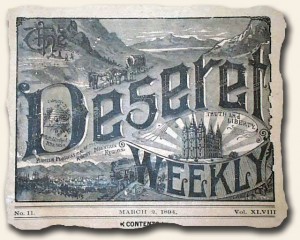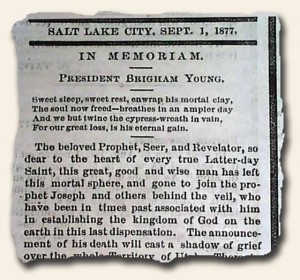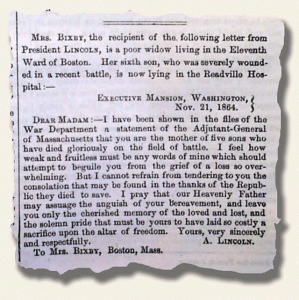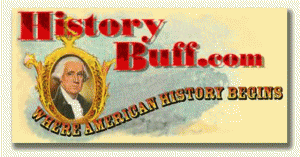Mormon history in newspapers…
March 15, 2013 by TimHughes · 3 Comments
As is true with any historical event or founding of an institution, collectors of historical newspapers strive for the earliest reports possible. The Declaration of Independence first appeared in a newspaper on July 6, 1776, and that issue commands a six figure price much higher than printings of the document in other newspapers of later dates  (such as the British Gentleman’s Magazine from August, 1776). Battle reports from the Revolutionary War are most coveted when in newspapers dated as close to the battle as possible. With the widespread use of the telegraph just before the Civil War, timeliness became less of an issue, as events would typically be found in the next day’s edition of newspapers regardless of how distance the printing press was from the event.
(such as the British Gentleman’s Magazine from August, 1776). Battle reports from the Revolutionary War are most coveted when in newspapers dated as close to the battle as possible. With the widespread use of the telegraph just before the Civil War, timeliness became less of an issue, as events would typically be found in the next day’s edition of newspapers regardless of how distance the printing press was from the event.
With institutions, societies & organizations the collector strives for the earliest reports on their creation. Reports from the Continental Congress, the Constitutional Convention, the creation of military academy at West Point, the first baseball game mention, are just a few examples of icons of present-day societies which collectors like to find in newspaper reports dated as early as possible.
Such is true with development of the Church of Jesus Christ of Latter-Day Saints, or the Mormons. Formally organized in upstate New York in 1829 accounts from that year or 1830 would rank among the most desired. Our earliest account was found in the ‘Christian Intelligencer” issue of February 4, 1831. As was typical with reporting of the day, bias, discrimination and prejudice were rampant within the newspaper pages, with the publisher’s mind-set not encumbered by political correctness. This early report notes that: “…the career of some fanatical individuals, who pretend to work miracles and to preach a new gospel. They profess to have discovered somewhere in New York a new revelation, hidden under a stone, which enables them to work miracles…a delusion and phrenzy with which these individual have wrought up the public mind…something like 500 adherents who follow those ignorant and deluded men with the same submission that sheep are led to slaughter…”. This intriguing report was likely the first its subscribers learned of this new religious movement,and with a current membership of over 14 million, this report dates to when just 500 were followers.
 A slightly later report in the popular ‘Niles’ Weekly Register‘ newspaper from Baltimore, July 16, 1831, shows a similar bias & prejudice: “…that certain knaves, pretending to have found some holy writings hidden under a stone…started a new religion! The leaders make bold pretensions and assert a gift to work miracles…now said to amount to 1,000 souls…some of whom…no doubt believe in all things that are told them…” and more.
A slightly later report in the popular ‘Niles’ Weekly Register‘ newspaper from Baltimore, July 16, 1831, shows a similar bias & prejudice: “…that certain knaves, pretending to have found some holy writings hidden under a stone…started a new religion! The leaders make bold pretensions and assert a gift to work miracles…now said to amount to 1,000 souls…some of whom…no doubt believe in all things that are told them…” and more.
Newspaper accounts found in the 1831-1835 period were very few and remain among the most desired among collectors.
By the time the leader Joseph Smith and the Mormons moved from Kirtland, Ohio, to Missouri and then Nauvoo, Illinois by 1839, reports in newspapers became more numerous, as their travels were often made dangerous by the suspicious locals who didn’t want them in their vicinity.
An interesting and desired collection of Mormon-related newspapers would include period reports of their movement westward, from New York to Ohio to Missouri to Illinois and ultimately to their own state of “Deseret” in the present-day state of Utah. With their arrival in 1847, Utah was not only not a state, it was not even a territorial possession. It was part of Mexico, but with the Treaty of Guadalupe Hidalgo which ended the Mexican War in 1848, it became a territory of the United States, and the disputes between the Mormons and the federal government would be legendary, the Mountain Meadows Massacre being among the most publicized. In additional to federal battles, disputes within their organization were quick to make the newspapers, and the practice of plural marriage did not set well with the typical Judeo-Christian ethic of the day.
 Typical of religious movements of the 19th century, the Mormons published several of their own periodicals, among the earliest and occasionally available being ‘Times & Seasons’ done during their turbulent stay in Nauvoo, Illinois. Within its pages was the report of the killing of founder and leader Joseph Smith. Other titles which occasionally surface for collectors are ‘The Latter-Day Saints’ ‘Millennial Star‘, the ‘Gospel Reflector’, and some three years after their arrival at Salt Lake City they set up the ‘Deseret News‘ in 1850, which was the first first newspaper to be published in present-day Utah, some 46 years before it would become a state.
Typical of religious movements of the 19th century, the Mormons published several of their own periodicals, among the earliest and occasionally available being ‘Times & Seasons’ done during their turbulent stay in Nauvoo, Illinois. Within its pages was the report of the killing of founder and leader Joseph Smith. Other titles which occasionally surface for collectors are ‘The Latter-Day Saints’ ‘Millennial Star‘, the ‘Gospel Reflector’, and some three years after their arrival at Salt Lake City they set up the ‘Deseret News‘ in 1850, which was the first first newspaper to be published in present-day Utah, some 46 years before it would become a state.
The fascinating and troublesome history of the Mormons and their trek across the frontier of America is now part & parcel of American history. Finding reports in newspapers from when they happened makes for an interesting segment of any rare newspaper collection.
Summing up the Revolutionary War through 1779…
January 25, 2013 by TimHughes · Leave a Comment
The front page of “The Edinburgh Advertiser“, July 23, 1779, has a great letter (see below) signed by “An Englishman” which pretty much sums up the Revolutionary War through the mid-point of 1779. Never before have I seen a more accurate appraisal of the situation in so few words.
Value of the internet…
May 13, 2010 by TimHughes · Leave a Comment
 I never fail to be amazed at the incredible wealth of information which is available on the internet, and I never fail to be thankful for such an incredible resource, particularly remembering what it took thirty years ago to research a newspaper.
I never fail to be amazed at the incredible wealth of information which is available on the internet, and I never fail to be thankful for such an incredible resource, particularly remembering what it took thirty years ago to research a newspaper.
Back in the 1970’s and ’80’s, when I wrote up an issue for the catalog I had to pull out the encyclopedia if I was unsure of a specific date or consequences of a certain battle. And I also kept close at hand other resources which would document events I was finding in our inventory of newspapers.
But today, more information than I could possibly need flashes on my screen in a matter of seconds. What was the date James Buchanan died? Wikipedia tells me more quickly then it takes me to type “james buchanan”. Many times I’ll read an interesting article about a person which sounds intriguing but is lost to my memory. The web quickly provides a wealth of detail.
What brings this to mind is an entry I worked on this morning. The “Army & Navy Journal” of Dec. 3, 1864 has a touching item about a Mrs. Bixby who received a letter of condolence from Abraham Lincoln for her loss of five sons in the Civil War, the sixth was lying wounded in a hospital. The article includes the letter by Lincoln. Not having heard of this letter, as a whim I decided to Google “mrs. Bixby letter” to see if this was an “event”. To my surprise there is more to the story than the article could give, thanks to the “Collected Works of Abraham Lincoln”.
The touching letter by President Lincoln can be read in the photo. Below is the “rest of the story”:
Credit: “Collected Works of Abraham Lincoln”: In the fall of 1864, Massachusetts Governor John A. Andrew wrote to President Lincoln asking him to express condolences to Mrs. Lydia Bixby, a widow who was believed to have lost five sons during the Civil War. Lincoln’s letter to her was printed by the Boston Evening Transcript. Later it was revealed that only two of Mrs. Bixby’s five sons died in battle (Charles and Oliver). One deserted the army, one was honorably discharged, and another deserted or died a prisoner of war.
The authorship of the letter has been debated by scholars, some of whom believe it was written instead by John Hay, one of Lincoln’s White House secretaries. The original letter was destroyed by Mrs. Bixby, who was a Confederate sympathizer and disliked President Lincoln. Copies of an early forgery have been circulating for many years, causing some people to believe they have the original letter.
The point of this piece is to cite just one example how the internet opens a whole new world to the tidbits of history we find within early newspapers. A 150 year old article might pique the curiosity, but it is the internet which can satisfy. It’s a fascinating combination of very old & very new technology which fit so well in this hobby we love. Give the internet a try with some articles in your collection. You may be pleasantly surprised at what you will find.
Rick Brown & HistoryBuff.com – Featured Website!
November 17, 2008 by GuyHeilenman · 1 Comment
Rick’s entry into the hobby took a path similar to Timothy Hughes’. He started collecting historical newspapers in 1965 when he purchased a Philadelphia Inquirer for the capture and death of John Wilkes Booth. As he held his new purchase in his hands, he was suddenly struck by what many since him have come to realize: “History is never more fascinating than when it’s read from the day it was first reported”. He describes this first encounter with historic newspapers himself…
Booth. As he held his new purchase in his hands, he was suddenly struck by what many since him have come to realize: “History is never more fascinating than when it’s read from the day it was first reported”. He describes this first encounter with historic newspapers himself…
“Reading the emotion-filled accounts from actual witnesses suddenly opened a new door for me. Before, my viewpoint of history was that it was just a series of dates, names and events. Reading the actual eyewitness accounts made the names and events come to life. Imagine, being able to hold something in your hands that was “alive” when the event happened — 100, 200 or even 300 years old. For the next four years I literally purchased every old newspaper I could find. By 1969 I realized that I was running out of storage room…”
By 1969 he became a mail order dealer in historic newspapers. In 1984 he started a publication for newspaper collectors, “Collectible Newspapers”, which featured journalism history articles.
Tim fondly remembers the publication and the extraordinary efforts of Rick to bring together newspaper collectors from all corners of the country–and across the globe as well.
“Rick was a true hobbyist. He expended much effort and money to provide a channel to bring together all collectors under a common banner–the Newspaper Collector Society of America (NCSA). Never was he motivated to profit by the hobby. In more ways then he might admit, Rick did much to help the fledgling hobby grow. Rick’s a terrific guy and remains an extremely valuable resource for the hobby” says Tim.
In 1995 he discovered the internet, and by October 1995, Rick had a small website utilizing articles he had first printed in “Collectible Newspapers.” By January 1997, the site was getting 25,000 hits per month, and he could no longer justify the publishing costs for 25,000 people, so he ceased publishing the print version with the April 1997 issue.
Now, thirteen years later, HistoryBuff.com is reaching nearly 90,000 unique viewers AND 500,000+ PAGE VIEWS monthly. In October 2003, HistoryBuff.com was granted nonprofit status at both the federal and state level. While donations help keep HistoryBuff.com online, Rick fills in with money of his own. As with most nonprofits, financing is always a chore and there is seldom enough to keep it going. He has never taken pay for his work; truly a labor of love.
The HistoryBuff.com website provides a wealth of historical information beneficial to both novice and well-seasoned historians. It describes itself as:
“…a nonprofit organization devoted to providing FREE primary source material for students, teachers, and historybuffs. This site focuses primarily on HOW news of major, and not so major, events in American history were reported in newspapers of the time. In addition, there is information about the technology used to produce newspapers over the past 400 years.”
A sampling of resources provided at HistoryBuff.com includes:
-
- Reference Library (articles from Collectible Newspapers)
- Historic Panoramas (30 and counting)
- Newspaper Collecting
- Online Newspaper Archive
- Newsletter Archives
The most recent addition to the website is panoramas of historic sites in America. Upon entering, you will be treated to a guided tour of more than a dozen well-known historic sites.
Whether your primary interest is history or the collection of “History in Your Hands” via newspapers, the resources available through these links will prove to be invaluable. As a former educator, I particularly appreciate the access to Rick’s Interactive Quizzes. Subscriptions to the monthly EMAILED newsletter are available at no cost.
If you have yet to browse through the pages at HistoryBuff.com, a treat awaits. Warning: Before visiting, make certain you’ve cleared your schedule for a few hours. Walking through history is a trek worth savoring. Thanks Rick!
Feel free to comment on your visit (or more likely… visits) to HistoryBuff.com.


